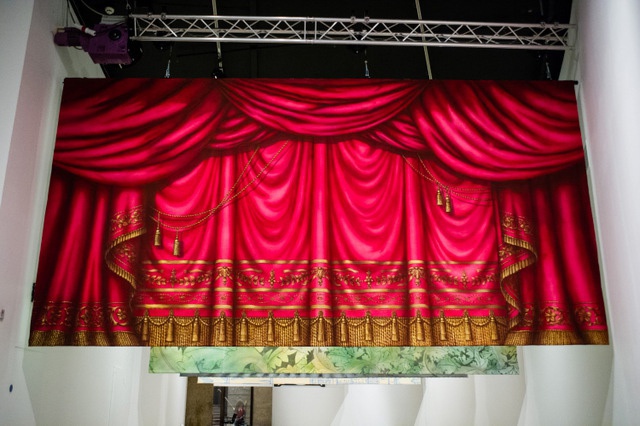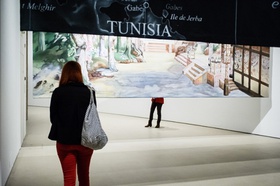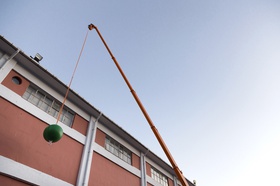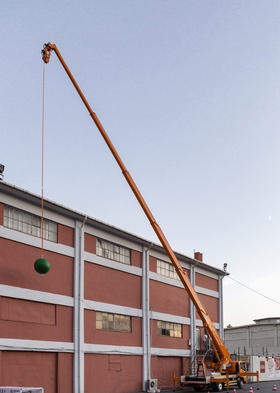Interviews
Building Mental Infrastructures
Ayşe Erkmen in conversation with Basak Senova
Ayşe Erkmen is an artist who is known for outstanding research-based, site-specific projects. Since the early 1980s, she has experimented with and implemented numerous formats, techniques and media by utilizing diverse verbal and visual languages. Her projects always superimpose current situations and conditions with spatial and perspective questionings. Hence, her starting point is always a deep research on the history and political implications of the places and locations that her projects are sited at. Therefore, the spatial characteristics along with the cultural, ideological, social, historical, psychological, and political implications of the sites, have shaped the nature and format of each of her projects. This interview focuses on her recent two projects, bangbangbang (2013), which was presented at the 13th Istanbul Biennial in 2013, and Intervals (2013–14), which was presented at The Curve, Barbican Centre, London.
Basak Senova: Intervals brings a theatrical touch and pace to the gallery space with 11 randomly moving scenic backdrops. These backdrops not only transform a static space into a dynamic one, but they also control the movements and the perception of the viewer. They could block their view, but then also open up the horizon for them. The viewer could be trapped, could be stopped, and even could be forced to move. At the same time, they control the time sequences in between the intervals for the viewer. Therefore, you are not only questioning the awareness of the space, but also how time is being fractured and perceived. Could you explain how this work provides tidal situations?
Ayşe Erkmen: When I started thinking about The Curve at The Barbican the most crucial idea to follow was the curved corridor as a space for art and its own place as a location inside the building. This space had been built as a sound barrier between the concert hall and the busy street outside. This made the place very much connected to the entertainment activities happening inside. The orientation inside 'the curve' requires movement, walking or approaching as one cannot see the end from the beginning because of the very curved shape. I thought the end would need to expose itself right from the beginning; that the work should be one piece covering the whole space. And naturally I could not avoid the activities around the space such as music, drama, social gatherings.
This whole procedure of thought process brought me to this work, which is a kind of continuation of my previous works that had to do with images; especially the works Scenic Overlooks (2004) and Busy Colours (2005). Intervals is a mixture of both, a movement in real space and of tangible images.
BS: How important are the images on these backdrops? What was the process of selecting these specific ones?
AE: Actually, in the beginning the images on these backdrops were not of great importance for me but, rather, the backdrops as backdrops themselves. I was naively thinking of getting backdrops from the archives of theatres, making a selection from their collections and adapting these to The Curve. I learned in the process of making that theatres do not keep archives of backdrops after the theatre production ends. With this new fact I knew that I had to start from scratch and have them made anew.
BS: So, they were not selected, but commissioned with an intention not to build correlative or narrative sequences?
AE: The only criteria and principle that I could stick to from the beginning was that each image would not have anything to do with the following image and that there would be no narrative in the space other then the narrative each backdrop contains in itself.
BS: Could you tell more about the process of producing these backdrops?
AE: We searched for backdrop painters in and around London, which turned out to be an extremely interesting experience. I met these very interesting people who are not known outside the theatre and film circles. I could look into their archives and choose images that were the most familiar and recognizable to their own styles. We also went into the archive of the Guildhall School of Music and Drama and met the backdrop painter students and graduates and I am very glad that they were able to make three of the 11 backdrops which are in the exhibition.
BS: Speaking of sharing experiences, I would like to move back to your work bangbangbang that was presented at the 13th Istanbul Biennial. A wrecking ball swinging from a crane, placed outside of the Antrepo building. With a simple, yet strong gesture, the work duplicated the entire experience of the aggressive urban transformation and destruction of Istanbul.
In a similar manner to Intervals, through a straightforward spatial intervention, bangbangbang thrived to inhabit perceptive aspects and intensified personal experiences. Yet, bangbangbang also had a strong critical angle. Could you elaborate on this criticality in relation to your artistic practice in general?
AE: Süreyya Evren in one of his articles writes about the work bangbangbang: 'Ayşe Erkmen's bangbangbang had such a sweet green ball for demolition of the building and it was playing with the attractiveness of the demolition while resisting it. There was a weird trick in showing the aesthetics of the evil. We even thought maybe the crane could have been painted as well'. I think this statement accurately explains my idea of being political or critical. I feel that a strong appearance has a stronger impact and a hidden or an indirect message has a longer life and more complex being. Similar to the sentence above; the word 'trick' does not give us a definite explanation, it is not a word with one definition – it could be positive or negative; attractive or disturbing; or seductive, among other meanings. For me a critical or political work should be like that too; without a definite answer or with many answers and questions. Portrayal of 'evil with aesthetics' as I again quote from the above sentence is most clear in my works PFM-1 and others (2004) and Let it Flow (1999).
BS: You mostly work on site-specific projects. How do you feel about travelling projects?
AE: Mostly, I am more interested in the concept of the space rather than the form. Therefore, when a work travels it travels either with its own idea to the next location or it has a new idea in its new space. I change the work completely or I adapt the work. For instance, the works Das Haus (1993), shown at DAAD Gallery and at the Hamburger Bahnhof, or the work A, B, C, D (2008) at the ABC fair and The Answer (2013) at Tanas, Berlin. I like this; because it gives me the chance to think about a work I have done before once again and more intensively.
BS: Speaking of space and replacement, do you have any particular divergent approach or perception between the works produced for public spaces and the works that take place in indoor art venues?
AE: Yes I do. A work in a public space that stays for a long time or 'forever' and in the daily life of the public eye is a bit frightening for me. It either pleases, disturbs or gets lost by being institutionalized (all not good) and therefore becoming traditional. To escape this vulnerability, I try to do my best to give the work a schedule, so that the work develops over time to change things within itself, either by moving, getting lost from time to time, changing position, and so on.
A work in a white cube (such as an indoor art venue) starts from nowhere and is in a nowhere, where there is a huge amount of freedom. Artwork does not have to be as careful and concerned anymore as time is limited and space is meaningless.
Ayşe Erkmen lives and works between Istanbul and Berlin. She has taught at the Kassel Art Academy and the Frankfurt Staedelschule. In 2002, she received the Maria Sibylla Merian award, a bi-annual award given by the German Hessen province. Erkmen's work has been continuously on exhibition in local and international galleries and biennials for the last 20 years. Her solo exhibitions include, among others, Tactics of Invisibility, Witte de With, Centre for Contemporary Art, Rotterdam (2010); Weggefährten, Hamburger Bahnhof, Berlin (2008); and K21 Kunstsammlung Nordrhein – Westfalen, Düsseldorf (2008). She has also participated in numerous group exhibition including Manifesta 1, Rotterdam (1996) and Skulpturen Projekte, Münster (1997). She has also contributed to the 2nd and 4th International Istanbul Biennials, the Shanghai, Berlin, Gwangju, Sharjah, Christchurch Biennials and the Folkestone and Echigo Tsumari Triennials.




















